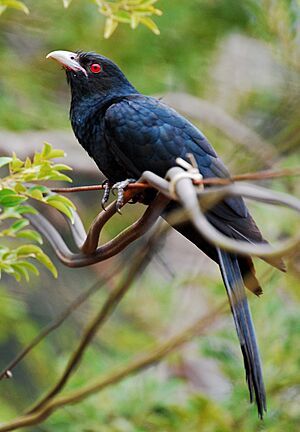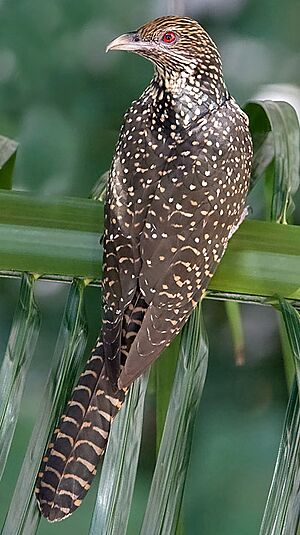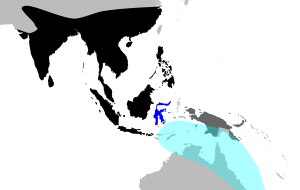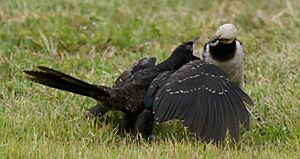Asian koel facts for kids
Quick facts for kids Asian koel |
|
|---|---|
 |
|
| Male (nominate race) | |
 |
|
| Female (nominate race)
|
|
| Conservation status | |
| Scientific classification | |
| Genus: |
Eudynamys
|
| Species: |
scolopaceus
|
 |
|
| The distribution of Asian koel in black | |
| Synonyms | |
|
|
The Asian koel (Eudynamys scolopaceus) is a type of cuckoo bird. You can find it in places like India, China, and Southeast Asia. It's closely related to the black-billed koel and Pacific koel.
Like many cuckoos, the Asian koel is a brood parasite. This means it lays its eggs in the nests of other birds, often crows. These "host" birds then raise the young koels as their own. Adult Asian koels are mostly fruit-eaters, which is a bit unusual for cuckoos. The name koel sounds like the bird's call. This bird is also a popular symbol in Indian and Nepali poems.
Contents
About the Asian Koel
What's in a Name?
The scientific name for the Asian koel is Eudynamys scolopaceus. The word Eudynamys comes from Ancient Greek words meaning "fine" and "power" or "strength." The word scolopaceus is a Modern Latin word that means "snipe-like."
There are different types of Asian koels depending on where they live. Some scientists think the black-billed koel and Pacific koel are the same species as the Asian koel. However, because they look and sound different, many now consider them separate species.
Different Types of Asian Koels
The Asian koel has several different forms based on where they live. These forms often have slightly different looks. Here are some of the known types:
- E. s. scolopaceus: Found in Pakistan, India, Nepal, Bangladesh, Sri Lanka, and the Maldives.
- E. s. chinensis: Lives in Southern China and Indochina.
- E. s. harterti: Found on Hainan island.
- E. s. malayana: Lives in the Thai-Malay Peninsula, Lesser Sundas, and Greater Sundas.
- E. s. mindanensis: Found in the Philippines and some nearby islands.
What Does the Asian Koel Look Like?
The Asian koel is a large bird with a long tail. It's about 39 to 46 centimeters (15 to 18 inches) long and weighs between 190 to 327 grams (6.7 to 11.5 ounces).
- Males: The male koel is shiny bluish-black. It has a pale greenish-grey beak, bright red eyes, and grey legs.
- Females: The female koel is brownish on its head. Its back, rump, and wings are dark brown with white and buff spots. Its belly is whitish with many stripes.
- Young Birds: Young koels look more like the males, but they have a black beak.
These birds are very noisy during their breeding season, which is from March to August in India. The male's song is a repeated koo-Ooo. The female makes a sharp kik-kik-kik... sound. Their calls can sound a bit different depending on where they live.
Where Do Asian Koels Live?
Asian koels like to live in light woodlands and farmed areas. They usually stay in tropical southern Asia, from Iran and Pakistan all the way to southern China and the Greater Sundas.
They are good at moving into new places. For example, they were among the first birds to live on the volcanic island of Krakatau after it erupted. They first came to Singapore in the 1980s and are now very common there. Some koels might even travel long distances, reaching places like Australia.
How Do Asian Koels Behave?
As mentioned, the Asian koel is a brood parasite. This means the female koel lays her eggs in the nests of other birds. They often choose the nests of jungle crows and house crows. In Sri Lanka, they used to only use jungle crows, but later started using house crows too.
Sometimes, the male koel might distract the host birds. This gives the female a chance to quickly lay an egg in the nest. Often, the female goes to the nest alone. Koels usually lay one or two eggs in a nest. Sometimes, a female koel might even remove one of the host's eggs before laying her own.

Koel eggs hatch in about 12 to 14 days. This is usually about 3 days before the host's eggs hatch. Unlike some other cuckoos, young koels don't always push the host's eggs or chicks out of the nest. When they are young, they even make sounds like a crow. The young koels leave the nest after 20 to 28 days. Adult female koels have sometimes been seen feeding their young in the host's nest.
What Do They Eat?
Asian koels eat many different things, including insects, caterpillars, eggs, and small animals. However, adult koels mostly eat fruit. They sometimes protect fruit trees they are eating from other birds. They are very important for spreading the seeds of trees like the sandalwood tree in India. They can swallow large fruits whole. They have even been seen eating fruits that are poisonous to mammals.
In Culture
The name "koel" sounds like the bird's call. In ancient Indian languages like Sanskrit, the bird is called "Kokila," which also sounds like its call. Because of their loud calls, Asian koels appear often in stories, myths, and poems. In ancient Indian texts, they were seen as special birds and protected from harm. Some old writings even mentioned that they were "raised by others," which is thought to be one of the earliest mentions of brood parasitism. The Asian koel is the state bird of Puducherry in India.
These birds were once popular as pet birds in India. They were tough birds and could live for up to 14 years in captivity, even eating simple foods like boiled rice.
Images for kids








